
Entertainment, Leisure & Sport
General sport & entertainment
In Dockyard times, numerous clubs and sports teams offered Pembroke Dock's citizens an active
and varied social life. In one week of 1911, for example, Albion Square Chapel presents a concert
featuring Miss Gwladys Roberts and Senor Soler Gomez, and a young peoples' guild "German night."
The Liberal Club holds its mock parliament, Wesley and Albion Square chapel guilds debate capital
punishment, the RAOB holds its dinner, and Bethel Sunday School is busy. In the 1905 cricket
season, one week's matches feature Wesley vs. the garrison, Docks vs. Neyland and the Dockyard
fitters vs. the Docks 2nd. team, "played on the Barrack Hill".
(Sources: MNG 27 Jan 1911; PDJ 29 Jun 1905)
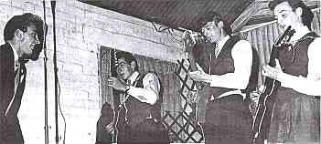

The Valiants in the Double Two club, 1963
Music: brass bands, choirs & dances.
In the town's early days, regimental bands provided music at parades and launching ceremonies.
They also gave public concerts in the Temperance Hall, and sometimes on the slopes of the
Barrack Hill. The 9th East Norfolk Regiment was noted for "their beautiful band and the Italian
bandmaster, Signor Bonicoli." Later bands included the Salvation Army band and the town band,
which still flourishes.
Chapel and church choirs would meet to practise for local concerts, as well as for Sunday services.
Going further afield, the Pembroke Dock Choral Society won the 1907 Swansea National
Eisteddfod. Today's Pembroke and District Male Voice Choir continues this tradition; since 1952, it
has performed in venues including the Royal Albert Hall.
Dances were sometimes military functions. In June 1871, officers of the 13th regiment played host
to four hundred members of the county elite at "a grand military ball" in the hut encampment -
later Llanion Barracks. Empire Air Day 1934 concluded with a ball in the station gymnasium, which
was lit by a dozen giant Chinese lanterns. Norman Grieve's dance band played, with a noteworthy
piano accordion solo. Dances in the Dockyard hangars are also remembered.
Other dances had less direct military links; Pennar Barracks became a holiday camp. It had one of
the largest dance pavilions in Wales, where top groups of the 1960s performed.
(Sources: Peters 75; Carradice 88; Scot, The boss... ; Rees 23-4; undated cutting)
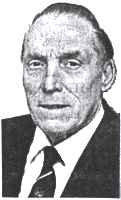
Pictures by courtesy of The Western Telegraph

Entertainment, Leisure & Sport - Theatre & cinema
Some of the first plays in Pembroke Dock were staged by companies of travelling players. In portable theatres or wooden sheds,
rapt audiences would follow the deeds of melodramatic villains and heroines. "Maria Martin" was a particular favourite.
Mr Ord's theatre, one such wooden structure, stood around 1860 near Gwyther Street. A regular patron was the senior Dockyard
officer, Captain Ramsay, R.N., respected for his "smiling face and kindly, thoughtful nature". Groups of boys often stood around the
theatre door, with nothing else to do and no money. On his way in, Captain Ramsay would buy them all tickets.
An evening's entertainment in 1860 featured "Caractacus King of Britain", a farce, in which "Mr Ord's witticisms drew forth roars of
laughter". Accompanying music from the Pembroke Rifle Corps band, the reporter notes, is more enjoyable now each performer is
"familiarised with his instrument".
In the early twentieth century Berger's Palace, in Queen Street, presented both stage shows and cinema. 1919 advertisements
offer, for example, both "the merry Dukes" - an army show from Bush Camp - and the film "Mystery of the double cross"
In 1917 the Grand Cinema was offering attractions such as "Home: a grand picture with a fine moral ... in which Bessie Barriscale
will be featured", "exciting adventures of Protea, girl without fear" and Charlie Chaplin. By 1933, new technology permitted sound
films such as "Radio parade" and "Waltz time". In the 1930s late night audiences leaving the Grand would head, en masse, for the
nearby Monti's cafe. The Grand finally closed in 1974.
Alongside such attractions, amateur concerts, plays and pantomimes flourished. 1947 saw a particularly imaginative interpretation
of "Aladdin", featuring a fine pair of stage drunks and a convincingly oriental pantomime horse.
(Sources: Peters 136-7; Mason 53; Howell, David W 450; PH 30 Nov 1860; NN 30 Aug 1919, 21 Oct 1933; PDG 14 Sept 1917; Hogg, Lost PD; South
Pembrokeshire Players; Scott, Cafe part II )
Picture by courtesy of Pembrokeshire Record Office.
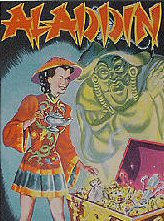

Entertainment, Leisure & Sport - Travelling shows
SMrs Peters conveys the colour and excitement of pre-1905 visiting shows . The first circus, as
well as travelling waxworks and menageries, set up near today's Hawkstone Road - then an
open field. The earliest roundabouts were pushed around by boys, given "a free ride after a
certain number of turns". Next came roundabouts driven by ponies, then steam, "finally
leading up to the gorgeous gondolas and moving animals belonging to Mr H. Studt", with their
ringing organ music and electric lights. Mr Studt contributed generously to local charities.
The most spectacular show to visit Pembroke Dock arrived in 1904 - "Colonel Cody (Buffalo
Bill) brought his gigantic show of the Wild West here, and his North American Indian, Cossack
and other daring riders. They gave their magnificent display of horsemanship and marvellous
shooting in a large field" (near today's Quins' ground).
(Sources: Peters 137-9) Picture by courtesy of Cofio, Tenby.
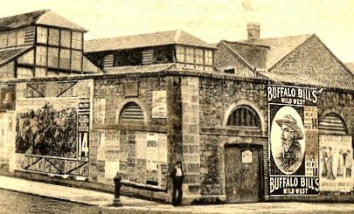

Entertainment, Leisure & Sport - Games & sports
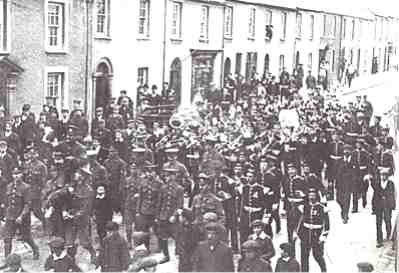
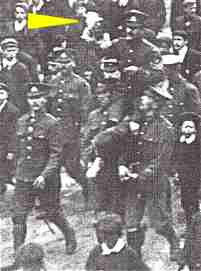
The champions! The Rugby team of the 2nd battalion, the Welsh Regiment won the the 1911-12 season cup. Here, complete with band,
they carry the trophy shoulder high down Laws Street.
Early Dockyard workers enjoyed playing marbles and a similar game, "lead birds". Players would try to hit small lead
birds, camels, elephants and other animals. One contestant would call "who'll have ?", then give a loud whoop. Any
challenger would reply "All right, stick her up", and the game would proceed. Feelings sometimes ran high - "this game
often led to disputes and fisticuffs".
Team games absorbed more aggressive energies. Knappon, a traditional Pembrokeshire sport, was played in early
Pembroke Dock - Shrove Tuesday was the great day for "street hockey" in King Street.
Later fields and pitches on the Barrack Hill, at Bierspool and near today's park catered for cricket, rugby and football.
A Welsh League football fixture, such as the 1925 Pembroke Dock / Swansea match, could draw as many as 3,000
spectators. Players from the Dockyard and local regiments gave Harlequins rugby teams particular strength. Today's
'Quins play on, a century after the club was founded.
An exceptionally talented Pembroke Dock footballer, Frank Donovan, played in the Great Britain team in the 1948
Olympics, scoring a remarkable thirty yarder goal in the semifinal match against Jugoslavia.
Early tennis clubs representing bodies such as churches and chapels played at the town's various barracks. Other small
tennis clubs had courts at Llanion, Bierspool and Kingswood. After 1925, the Memorial Park offered a venue for relaxed
matches, and for more serious players. Mr Frank Owen recalled "terrific battles" between Harry Macken and Mr Worth
of the RAF. These epic matches attracted people from all over the county. The park's bowling green flourished in an
atmosphere of less strident rivalry.
Another somewhat contemplative game, billiards, arrived in the late 1800s. Billiards halls added to the attractions of
the Mechanics' Institute, and the Liberal Club. A senior figure here was Mr Sam Sloggett, redoubtable billiards room
steward of the Mechanics' Institute.
Sources: Reynolds, Old Pater ... ; Carradice 83; Peters, Sidelights...; Peters 133, 136; Howell, David W 432; Nannestad; Army ... foundations;
Mason 103. )
Pictures by courtesy of Pembroke Dock Museum Trust.
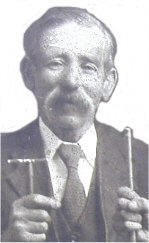
Mr Sam Sloggett, 1930

Entertainment, Leisure & Sport - Sports days, cycling & regattas

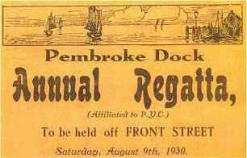
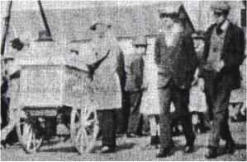
Regattas have been held since Victorian times. This notice is from an
1848 Pembrokeshire Herald
Front Street and Pennar Regattas were a feature of Summer life. Mr
Giovanni Monti (right, with flat cap and ice cream cart) provided
refreshment
Early "rustic sports" days and pony races enlivened the Barrack Hill. One such event in 1855 attracted, it was claimed, between three and four thousand
spectators. The annual fair at the watery meadow (a field near today's Police Station) offered "all sorts of athletic games - foot races, donkey races and such
like". The athletics ground, near today's park, became a more permanent venue. Cycle racers sped through the streets on penny farthings in the 1880s. Later,
large crowds would attend rather safer cycle races at the far end of Fort Road. As befits a shipbuilding town, yachting regattas have been popular since Victorian
times.
(Sources: Peters 136-8; HMT 4 Jul 1855)
Pictures by courtesy of: Regatta notice, Pembrokeshire Record Office - Regatta programme, Pembroke Dock Museum Trust - Mr Monti, The Western Telegraph.


Entertainment, Leisure & Sport - Hobbies & craftsmanship
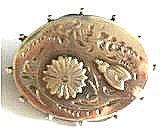
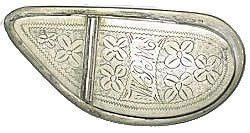

Brooches and snuffbox, made by Dockyard craftsmen in spare moments at work.

TOP
HOME
(Amendment, updates and additions) (AJ) Anndra Johnstone
This site is designed, published and hosted by CatsWebCom Community Services © 2018 part of Pembroke Dock Web Project


































